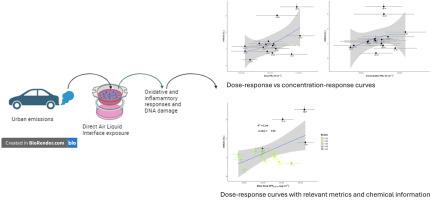城市大气中细微颗粒和超细颗粒的剂量-反应关联:空气-液体界面实际暴露剂量对支气管细胞的毒理学结果。
IF 8.1
2区 环境科学与生态学
Q1 ENVIRONMENTAL SCIENCES
引用次数: 0
摘要
空气污染和颗粒物(PM)是导致全球死亡的主要环境原因。为了加强对人类健康的保护,暴露限值已经降低;因此,了解与人类实际暴露相关的低浓度空气中可吸入颗粒物的细胞模型的毒理学机制变得越来越重要。在吸入毒理学研究中,使用空气液体界面(ALI)模型来模拟空气中的污染物与肺上皮之间的相互作用也越来越重要。本研究报告了支气管上皮细胞 BEAS-2B 直接暴露于环境 PM1(即空气动力学直径小于 1μm 的颗粒)的 ALI 影响。暴露 24 小时后,对基因表达(HMOX、Cxcl-8、ATM、Gadd45-a 和 NQO1)、白细胞介素(IL)-8 释放和 DNA 损伤(彗星试验)进行了评估。我们报告了所选毒理学结果的剂量-反应曲线以及浓度-反应关联,结果表明这两条曲线在特定反应上存在差异,这突出表明浓度-反应关联可能与了解毒理学结果无关。值得注意的是,我们的研究表明,无论空气中 PM1 的质量浓度如何,新排放的颗粒物沉积可能会产生促氧化效应。此外,我们还表明,参考空气中的 PM1 指标,即空气中的质量浓度,并不总是能反映气溶胶引发的毒理过程。这些发现强调了考虑不同气溶胶指标来评估细颗粒和超细颗粒毒性的重要性。为了更好地保护人类健康,应该定义更多的指标,以考虑整个气溶胶混合物的特性,包括具体的颗粒大小(即空气动力学直径小于 20 纳米的颗粒)、相关气溶胶来源(如交通燃烧、二次有机气溶胶......)及其大气处理过程(新排放与老排放)。本文章由计算机程序翻译,如有差异,请以英文原文为准。

On the dose-response association of fine and ultrafine particles in an urban atmosphere: toxicological outcomes on bronchial cells at realistic doses of exposure at the Air Liquid Interface
Air pollution and particulate matter (PM) are the leading environmental cause of death worldwide. Exposure limits have lowered to increase the protection of human health; accordingly, it becomes increasingly important to understand the toxicological mechanisms on cellular models at low airborne PM concentrations which are relevant for actual human exposure. The use of air liquid interface (ALI) models, which mimic the interaction between airborne pollutants and lung epithelia, is also gaining importance in inhalation toxicological studies. This study reports the effects of ALI direct exposure of bronchial epithelial cells BEAS-2B to ambient PM1 (i.e. particles with aerodynamic diameter lower than 1 μm). Gene expression (HMOX, Cxcl-8, ATM, Gadd45-a and NQO1), interleukin (IL)-8 release, and DNA damage (Comet assay) were evaluated after 24 h of exposure. We report the dose-response curves of the selected toxicological outcomes, together with the concentration-response association and we show that the two curves differ for specific responses highlighting that concentration-response association may be not relevant for understanding toxicological outcomes. Noteworthy, we show that pro-oxidant effects may be driven by the deposition of freshly emitted particles, regardless of the airborne PM1 mass concentration. Furthermore, we show that reference airborne PM1 metrics, namely airborne mass concentration, may not always reflect the toxicological process triggered by the aerosol.
These findings underscore the importance of considering different aerosol metrics to assess the toxicological potency of fine and ultrafine particles. To better protect human health additional metrics should be defined, than account for the properties of the entire aerosol mixture including specific as particle size (i.e. particles with aerodynamic diameter lower than 20 nm), the relevant aerosol sources (e.g., traffic combustion, secondary organic aerosol …) as well as their atmospheric processing (freshly emitted vs aged ones).
求助全文
通过发布文献求助,成功后即可免费获取论文全文。
去求助
来源期刊

Chemosphere
环境科学-环境科学
CiteScore
15.80
自引率
8.00%
发文量
4975
审稿时长
3.4 months
期刊介绍:
Chemosphere, being an international multidisciplinary journal, is dedicated to publishing original communications and review articles on chemicals in the environment. The scope covers a wide range of topics, including the identification, quantification, behavior, fate, toxicology, treatment, and remediation of chemicals in the bio-, hydro-, litho-, and atmosphere, ensuring the broad dissemination of research in this field.
 求助内容:
求助内容: 应助结果提醒方式:
应助结果提醒方式:


